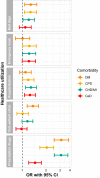Healthcare Utilization and Comorbidity in Chronic Lymphocytic Leukemia
- PMID: 35002328
- PMCID: PMC8722577
- DOI: 10.2147/CLEP.S337495
Healthcare Utilization and Comorbidity in Chronic Lymphocytic Leukemia
Abstract
Purpose: Age-related comorbidity is highly prevalent in chronic lymphocytic leukemia (CLL). The purpose of this study was to provide information on current patterns of healthcare utilization in CLL.
Patients and methods: We used data from Danish nation-wide registers to study healthcare utilization the year before and the year after CLL diagnosis and in relation to first-line treatment. Patients diagnosed with CLL between 1997 and 2018 were included and stratified on number of comorbidities, presence of specific comorbidities, and fitness status, respectively. Healthcare utilization was studied in terms of hospital admissions, in-hospital bed days, out-patient visits, emergency room visits, and prescription drugs. Odds ratios with 95% confidence intervals were calculated using multivariable logistic regression analyses adjusting for age, sex, and calendar year.
Results: The study comprised 9170 patients with CLL with a median age of 71 years, of whom 35% had ≥1 comorbidity. Healthcare utilization increased markedly upon CLL diagnosis both in patients with and without comorbidities. During the year after CLL diagnosis, 39% were hospitalized, 16% visited an emergency room, 88% visited an out-patient clinic, and 93% received prescription drugs. Both individual comorbidities and the total number of comorbidities were associated with increased healthcare utilization of all types, except for contacts to hematological departments.
Conclusion: Our results suggest that CLL diagnosis may unveil incipient diseases and aggravate comorbidities and thereby have considerably wider health implications than those directly related to CLL. These findings may be used by clinicians and decisions makers to guide planning of multidisciplinary care for cancer patients.
Keywords: chronic lymphocytic leukemia; epidemiology; hematology; real-world data.
© 2021 Rotbain et al.
Conflict of interest statement
ECR received consultancy fees or travel grants from AbbVie, Janssen, and AstraZeneca. CC-B received consultancy fees and/or travel grants from AbbVie, AstraZeneca, and Gilead. CUN received support from Novo Nordisk Foundation and AstraZeneca within this work and consultancy fees, or travel grants from AbbVie, Gilead, Janssen, Roche, CSL Behring, Acerta, Genmab, Sunesis, Takeda, Octapharma, and AstraZeneca outside this work. HF received support outside this work from Alexion, Gilead, AbbVie, Janssen Pharmaceuticals, and Novartis. HH received support from Neye Fonden outside this work. The authors report no other conflicts of interest in this work.
Figures


Similar articles
-
Medication Adherence, Health Care Utilization, and Costs Among Patients Initiating Oral Oncolytics for Multiple Myeloma or Chronic Lymphocytic Leukemia/Small Lymphocytic Lymphoma.J Manag Care Spec Pharm. 2020 Feb;26(2):186-196. doi: 10.18553/jmcp.2020.26.2.186. J Manag Care Spec Pharm. 2020. PMID: 32011965 Free PMC article.
-
Mapping comorbidity in chronic lymphocytic leukemia: impact of individual comorbidities on treatment, mortality, and causes of death.Leukemia. 2021 Sep;35(9):2570-2580. doi: 10.1038/s41375-021-01156-x. Epub 2021 Feb 18. Leukemia. 2021. PMID: 33603143
-
Real-World Treatment Patterns, Adverse Events, Resource Use, and Costs Among Commercially Insured, Younger Patients with Chronic Lymphocytic Leukemia in the USA: A Retrospective Cohort Study.Adv Ther. 2020 Jul;37(7):3129-3148. doi: 10.1007/s12325-020-01350-w. Epub 2020 May 12. Adv Ther. 2020. PMID: 32399812
-
The Danish National Chronic Lymphocytic Leukemia Registry.Clin Epidemiol. 2016 Oct 25;8:561-565. doi: 10.2147/CLEP.S99486. eCollection 2016. Clin Epidemiol. 2016. PMID: 27822100 Free PMC article. Review.
-
BCL-2 Inhibition as Treatment for Chronic Lymphocytic Leukemia.Curr Treat Options Oncol. 2021 Jun 10;22(8):66. doi: 10.1007/s11864-021-00862-z. Curr Treat Options Oncol. 2021. PMID: 34110507 Review.
Cited by
-
Assessing the economic burden of Waldenström's Macroglobulinemia (WM), Marginal Zone Lymphoma (MZL), and Chronic Lymphocytic Leukemia (CLL).Glob Reg Health Technol Assess. 2025 Mar 11;12:80-88. doi: 10.33393/grhta.2025.3365. eCollection 2025 Jan-Dec. Glob Reg Health Technol Assess. 2025. PMID: 40083541 Free PMC article.
-
Health Care Use Among Cancer Patients With Diabetes, National Health and Nutrition Examination Survey, 2017-2020.Prev Chronic Dis. 2024 Aug 8;21:E58. doi: 10.5888/pcd21.240066. Prev Chronic Dis. 2024. PMID: 39117352 Free PMC article.
-
Real-World Evidence on Adverse Events and Healthcare Resource Utilization in Patients with Chronic Lymphocytic Leukaemia in Spain Using Natural Language Processing: The SRealCLL Study.Cancers (Basel). 2024 Nov 29;16(23):4004. doi: 10.3390/cancers16234004. Cancers (Basel). 2024. PMID: 39682190 Free PMC article.
References
-
- da Cunha-bang C, Simonsen J, Rostgaard K, Geisler C, Hjalgrim H, Niemann CU. Improved survival for patients diagnosed with chronic lymphocytic leukemia in the era of chemo-immunotherapy: a Danish population-based study of 10455 patients. Blood Cancer J. 2016;6:e499. doi:10.1038/bcj.2016.105 - DOI - PMC - PubMed
-
- Noone A, Howlader N, Krapcho M, et al. SEER cancer statistics review, 1975–2015, National Cancer Institute. Bethesda, MD; 2018, https://seer.cancer.gov/csr/1975_2015/. Accessed December 15, 2021. based on November 2017 SEER data submission, posted to the SEER web site, April 2018.
LinkOut - more resources
Full Text Sources

